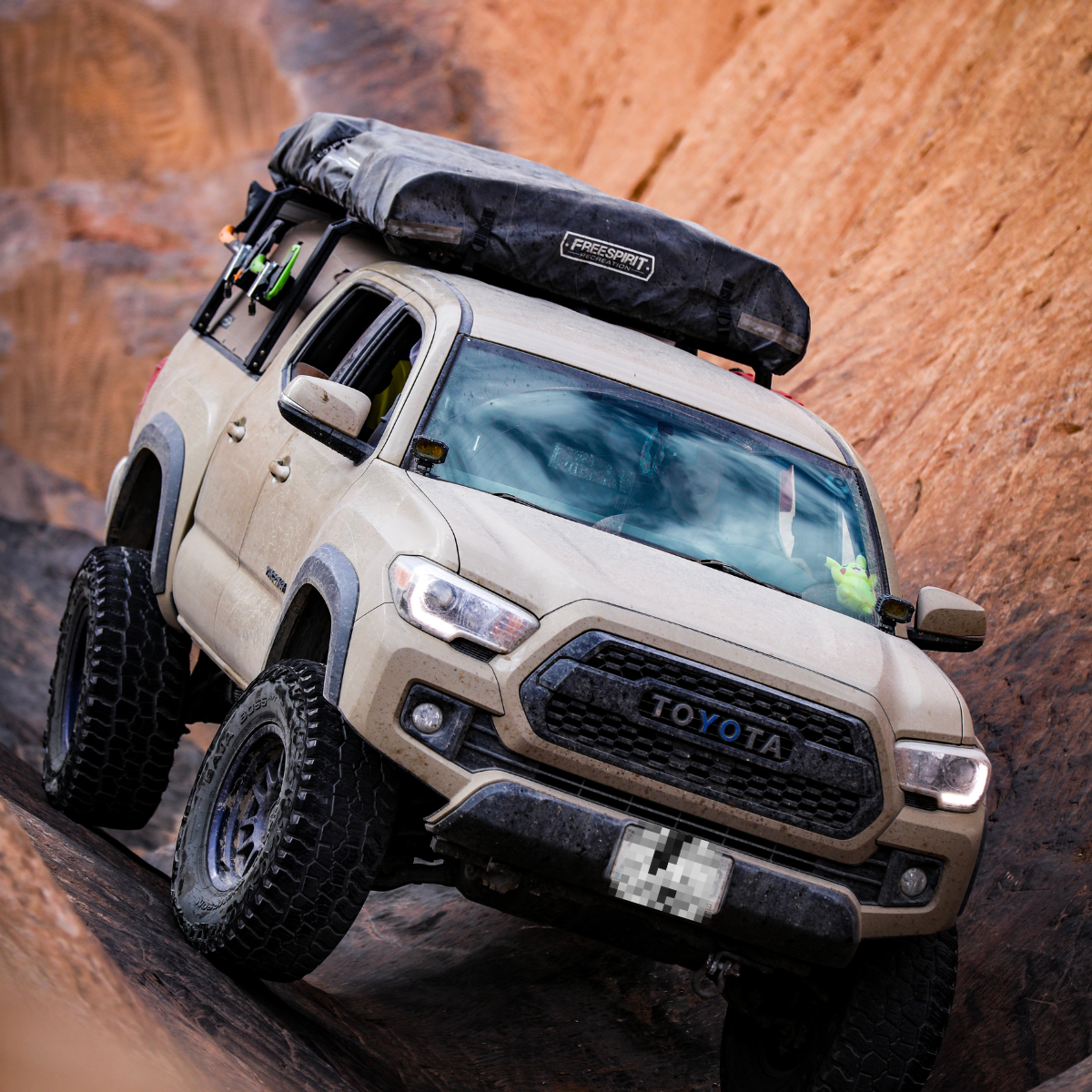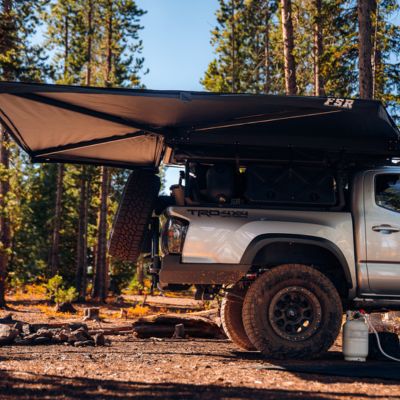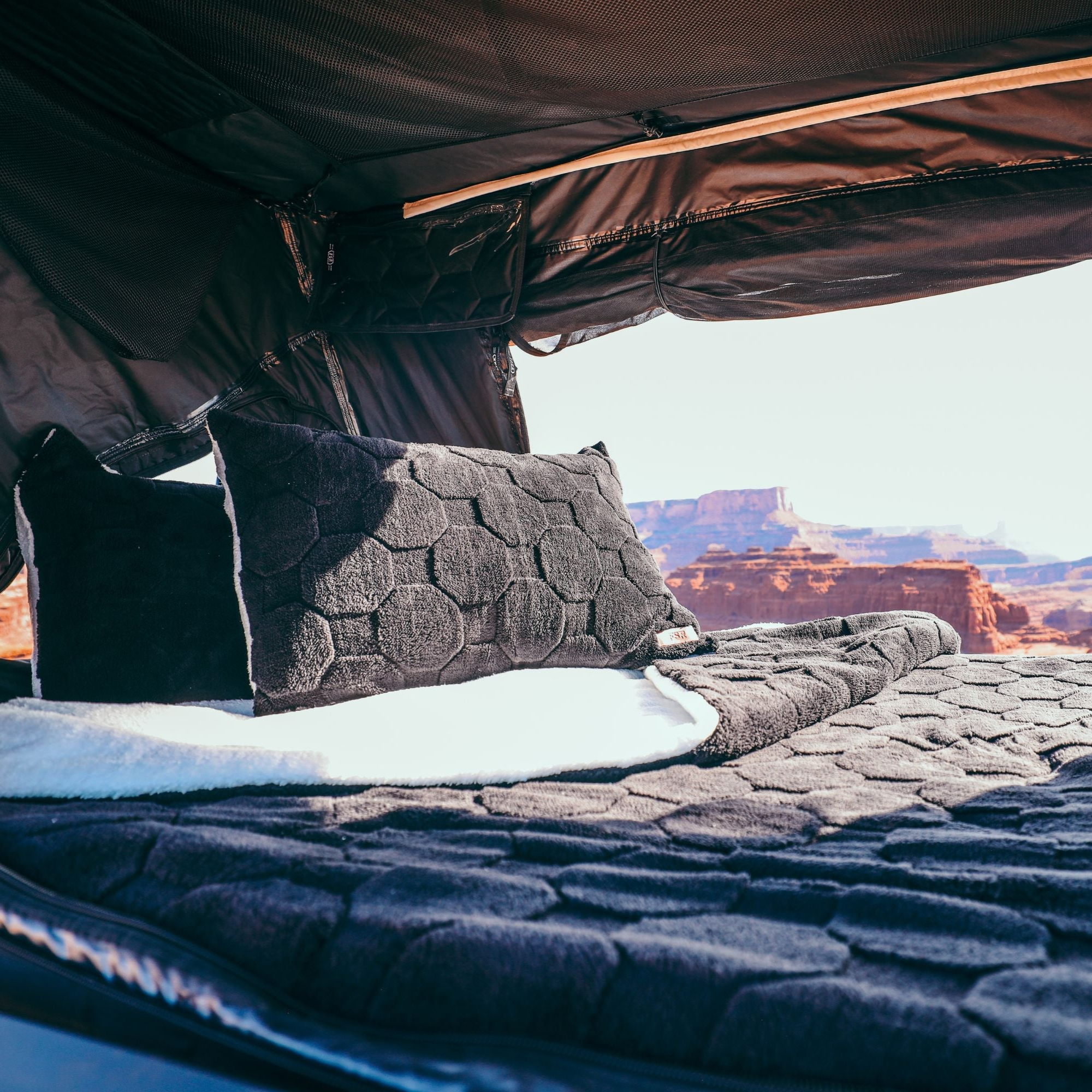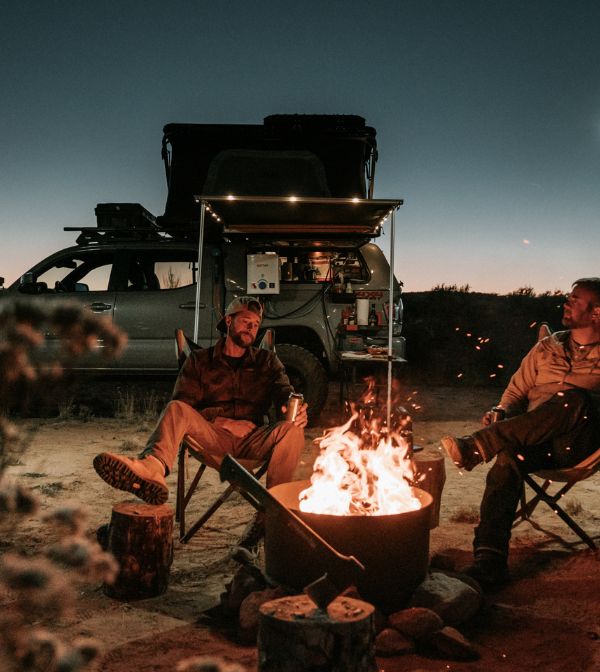Camping is experiencing a renaissance. The beauty of camping at this time in history is that everyone can enjoy it. Gone are the days of “going camping” inherently meaning “roughing it”. With more capable 4x4 and AWD vehicles available at every price point and the evolution of camping tents from poorly insulated polyester canopies on the cold hard ground to highly technical, comfortable rooftop tents with adjustable mattresses, camping no longer has to be synonymous with type two fun.
When you choose to go camping in 2024, you essentially have a menu of options to choose from. There’s backpacking if you still prefer to rough it. There’s hiking in when your campsite isn’t quite accessible by vehicle — it’s a bit like backpacking but the respite of your car or SUV is typically mere yards away. There’s glamping which can mean anything from camping in a furnished tent at nightly rates to camping in your own decked-out RV or travel trailer. Then finally, you have car camping and good old-fashioned tent camping.
What’s the Difference Between Car Camping and Tent Camping?
In 2024, tent camping doesn’t mean you’re stuck down on the ground where creatures of the night like bears and crafty raccoons roam around. With the explosion of overlanding, rooftop tents have set a new paradigm and higher (pun intended) standard for tent camping. While traditional tents still has a time and a place, this article will specifically be zooming in on camping in rooftop tents for cars, trucks, and SUVs.
But what’s the difference between car camping and camping in a rooftop tent? When’s it best to fold down the seats in your hatchback versus climbing up into your perch on the roof? Read on as I dive into all the minutiae — the differences between car camping and rooftop tent camping and the pros and cons of each — to help you determine which option suits your next adventure.
What Is Car Camping?
Some might say, “Isn’t rooftop tent camping also car camping?”
You could say that. After all, they both require a vehicle as the platform for camping in or on. But the experiences of camping in a rooftop tent versus sleeping inside your rig are very different. Each has its own set of considerations and logistics to plan for. That’s why I prefer not to use these terms interchangeably.
The act of car camping means you’re sleeping inside your vehicle at a campsite — whether dispersed or established. This can look like anything from the die-hard dirtbaggers who curl up in their sleeping bags in the backseats of sedans to more luxurious setups with air mattresses in SUVs.
In the past, I’ve spent weeks at a time car camping with my husband and our two dogs inside our 5th generation Toyota 4Runner. With the backseats folded down, the trunk is comfortable and roomy enough for two people. We’ve even managed to situate our dogs in a very particular way that allows us all to sleep soundly.
All that to say, it can be done, even for extended trips.
And you can have a good time doing it… but a successful, enjoyable car camping trip (especially when you’re not riding solo) comes down to developing systems for managing, gear, food storage, sleeping arrangements, etc.
I’ll dive deeper into all that after covering a few common cars that work well for car camping.
What To Look for When Choosing the Best Vehicle for Car Camping and Rooftop Tent Camping
Typically, when car camping as a couple, family, or someone who just wants to wake up feeling refreshed enough to actually enjoy the outdoors, you’ll sleep in a vehicle with backseats that fold down or stow away. This allows for space to make a bed.
As mentioned earlier, there are tons of options on the market that accommodate car camping excursions and rooftop tents. If you’re really determined, just about any car will do. However, if you want the best experience there are a few important features to consider when shopping for a rig.
Choose a car with AWD or 4WD and decent ground clearance. Even many designated campsites are accessed by dirt roads that can become rutted out, muddy, or poorly maintained. You want to be sure your car can get you there and back without needing to call for a recovery. Static and dynamic load capacity refers to how much weight your vehicle can support on the roof while parked/unmoving and while in motion. This is critical when it comes to both mounting a rooftop tent and adding gear to a roof rack to make room in the cabin for car camping. Payload capacity refers to the amount of weight your vehicle can safely carry — from gear and equipment to passengers. For the sake of car camping, the higher the payload, the better. Between passengers, dogs, camping gear, and after market modifications like steel bumpers or roof racks, weight can add up quickly. The size and configuration of the cabin in the car you choose for car camping are paramount. Again, look for a vehicle with folding or stowing rear seats. Also, consider the height of whoever will be sleeping in the vehicle. Taller campers need more legroom and any extra space inside the cabin means more room for storing gear out of the elements.
Common Vehicle Choices for Car Camping
Some of the best vehicles that work well for car camping are
- Toyota 4Runner - These SUVs come stock with impressive 4WD capabilities, large cabins, plenty of payload capacity, and a static load capacity of up to 600 lbs, the rear seats also fold down easily for roomy sleeping quarters.
- Honda CRV - Is available in 4WD and AWD, is fuel efficient, and has foldable seats that allow room for two.
- Honda Element - While ground clearance leaves something to be desired, the interior is surprisingly roomy with rear seats that fold onto the sidewalls, into the floor, or can be removed completely leaving a clean slate for a car camping build.
- Toyota Tacoma - Highly off-road capable stock from the factory with tons of aftermarket add ons available, Tacomas are great platforms to add a bed topper for car camping in or a bedrack to mount a rooftop tent.
- Subaru Outback - Would this really be a post on car camping without mention of a Subaru? With AWD, foldable rear seats, and an impressive 9.5 inches of ground clearance on the Wilderness trim level as of 2023, the Outback remains a reliable commuter to camping rig.
Planning Tips and Considerations for Car Camping Trips
Already imaging waking up and taking in a golden-orange sunrise above an epic alpine view from your rear window? It really can be as awe-inspiring as it sounds. And, some planning and expectation management prior to the trip is the key to making sure those moments are just as idyllic as you envisioned.
One thing to know about car camping: It can be cumbersome.
In most cases when you’re car camping, your rig’s cabin is playing multiple roles at once. It’s your bed, the dog's bed, the gear storage space, and the place where passengers need to sit if you move the car — whether that be moving campsites, driving to the trailhead, or making a run into town.
Gear and Food Storage Tips for Car Camping
It’s important to keep in mind that, if your vehicle is loaded down with gear on the drive out, it’s all going to need to go somewhere when you make your bed. Roof racks are a good solution for cargo, but be mindful of how weatherproof your cargo storage is (or is not).
Another important consideration is food storage. You probably won’t fit your cooler or food bins inside the car when you’re camping in it unless you're alone and fine with tight quarters.
Leaving coolers and food bins out overnight leaves them susceptible to being raided by critters. Or worse, they can attract bears and other predators to your camp.
On the other hand, when camping in a rooftop tent, you have the option to load up your vehicle with gear, personal items, and food bins that you don’t want to leave outside overnight.
Disclaimer: Storing food inside vehicles isn’t always recommended. Especially in bear country — bears can get into your car if they really want to. In hot climates, your vehicle interior becomes like an oven that quickly melts ice and causes food to spoil.
That said, there will be times when it's appropriate to store food in a vehicle — and some people will do it even when it’s not — I’ve been guilty of that myself. Using bear-proof food storage bags and vaults, whether you’re storing your food bins and coolers outside or in your car, traps the scent of food inside and is challenging for animals to get into.
Whatever you do, have a plan in place ahead of time. You don’t want to find yourself at camp with a ton of gear, food, and backpacks and nowhere to put them.
The Pros and Cons of Car Camping
Yes, car camping can be cumbersome. There’s a lot of moving things around and securing, unloading, and re-securing gear. But it’s also a stealthy, accessible way to get outdoors with a low barrier to entry.
For some, car camping will be the perfect setup. For others, it may feel a bit insufficient, especially if you carry a lot of specialized gear for activities like hunting, rock climbing, kayaking, etc., or are camping with your whole family.
Car Camping Pros:
- There’s a minimal barrier to entry.
- Heat and A/C are accessible at any time.
- Great for folks who are new to camping, want to dip their toes in, or feel uncomfortable managing gear and equipment.
- The security of being inside a locked vehicle lends some peace of mind.
- Accessories are available to make the experience as luxe and comfortable as you’d like from air mattresses made specifically for common car camping vehicle models to twinkling lights strung across the headliner.
- Vehicles typically stay a little warmer than traditional camping tents on cool nights.
Car Camping Cons:
- Storage is limited and organizing cargo can become a lot of work.
- Gear and food often have to be stored outside and subject to inclement weather and wildlife.
- You have to pack up your bed to access the rear seats for passengers and cargo.
- Car camping can get messy. Expect a lot of dirt to get into the cabin from transferring gear in and out of the vehicle. If you have dogs, they have a tendency to track all kinds of outdoor mess in.
- Typically can’t sleep more than two people.
- Managing condensation overnight while car camping often requires cracking the windows which, in some climates, allows insects to get in unless you have insect screens.
Preparing for Camping in a Rooftop Tent
Like car camping, there are some considerations you’ll want to make before camping in a rooftop tent.
Personally, getting a rooftop tent was a game changer for my husband and me. It allows us to pack all the gear we need without making sacrifices. We often go on climbing trips, pack a paddleboard, and gear for offroading, and have a lot of cargo in general.
We hold fondly to the memories of our grit-building car camping experiences. We saw it all from raccoons eating all of our dog's food on night one to having nowhere to sleep after massive rainstorms prompted us to drag all our gear into the car, to a cooler tipping over on the drive that soaked our bedding with icy water. Needless to say, we were well ready for a rooftop tent.
It’s awesome to be able to load the car down with gear, climbing crash pads, and a cooler and not have to worry about where on earth you’re going to store it all when you sleep.
If you pack a lot of specialized gear, you have kids or you just don’t feel comfortable leaving your gear out overnight, a rooftop tent could be the perfect camping solution.
The Pros and Cons of Camping in Rooftop Tents
One thing to know about rooftop tent camping versus car camping? Camping in a rooftop tent is much more flexible. While there are more products available that up-level the car camping experience now than ever before, you can only stretch the potential of your rig’s interior so far.
In many cases, it’s easier to find a rooftop tent that checks all the boxes you desire from your camping accommodations than a car. From ultralight rooftop tents like Freespirit Recreation’s sub-110-pound Aspen Lite that work great on vehicles like Jeeps where the roof can’t support a ton of weight and the cabin doesn’t offer much room for sleeping to foldout rooftop tents that can fit a family of 4 like the Nova King, it’s not hard to find a rooftop tent that meets your unique needs.
Rooftop Tent Camping Pros:
- With innovative technical materials like Freespirit Recreation’s patented Tri-Layer material, quality rooftop tents are well-insulated and built to maintain comfortable temperatures in both hot and cold climates.
- Camping in a rooftop tent leaves the entire car available for cargo and food storage.
- There’s much less packing, unpacking, and shuffling around of cargo required with rooftop tent camping than with car camping.
- Rooftop tents provide a sense of security in that you’re up off the ground and not sleeping somewhere easily accessible to predators.
- FSR rooftop tents only take 30 seconds to 2 minutes to set up — a far cry from the (often frustrating) experience of pitching a traditional camping tent.
- FSR rooftop tents are 100% waterproof and designed to strategically mitigate condensation.
- Some rooftop tent models allow you to store bedding and pillows inside the tent (even when folded up) saving valuable cargo space inside your vehicle.
- You have the high ground and the views can’t be beat!
Headlining points in the argument against rooftop tent camping include:
- Not all models are ideal for weathering severe storms such as sustained high winds.
- Getting large dogs up into rooftop tents can pose a challenge and sometimes isn’t possible.
- Rooftop tents are not as secure as cars if being able to lock yourself in is something you’re worried about.
Which Is Better, Car Camping or Rooftop Tent Camping?
The verdict is for you to decide. Both car camping and rooftop tent camping can be vehicles for enjoying some incredible experiences, getting off the beaten path, and reconnecting with nature, your family, and yourself.
If you’re not ready to invest in a rooftop tent yet, don’t let that hold you back from getting out there! Load up the car and use some of the tips shared in this article to plan an epic car camping trip.
Stoked on the idea of a rooftop tent? Reach out to the folks at FSR.
You can also schedule an appointment to check out the newly renovated Freespirit Recreation showroom in Golden, Colorado, and find help getting matched with a rooftop tent that’s fit for the kind of camping or overlanding experience you’re dreaming of this season.


















Leave a comment
All comments are moderated before being published.
This site is protected by hCaptcha and the hCaptcha Privacy Policy and Terms of Service apply.